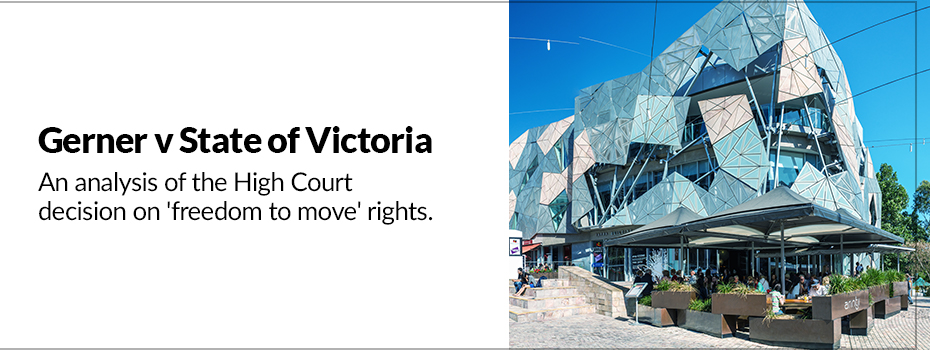
Freedom to move rights during a state of emergency?
01 August 2023 08:04
Case note: The High Court decision on Gerner v State of Victoria | Adam Parker, LexisNexis Australia
Emergency powers provide governmental agencies with the special authority they need to maintain public safety in extraordinary times. However, the decision to impose Lockdown Directions in Victoria during 2020 has had long-lasting and significant impact on many people’s lives.
Once the Victorian government declared a state of emergency across the whole of Victoria in response to the COVID-19 pandemic, emergency powers became available under ss 200(1)(b) and (d) of the Public Health and Wellbeing Act 2008 (Vic). These powers were then invoked to make Lockdown Directions that restricted Victorians’ movement within their state.
In the case of Gerner v State of Victoria [2020] HCA 48, a small business owner who had experienced a dramatic change in revenues from his restaurant and bar business in the Mornington Peninsula, decided to make a stand.
Gerner sought to have the Lockdown Directions, and their supporting legislation declared constitutionally invalid. He argued that the Constitution gave him implied freedom of movement that was being limited by the long-running Lockdown Directions imposed by the State of Victoria to prevent the spread of COVID-19 during 2020.
The way Mr Gerner framed his argument was quite unusual – he argued that a careful reading of the text of the Constitution would reveal a necessary implication that Australians have freedom of movement.
His position was that the freedom was an implication of the fact and manner of Federation, that this freedom of movement was in all cases essential to ensuring free political communication, and that the explicit protection of free movement between states provided by section 92 of the Constitution implies that people are free to move within these states.
From this perspective, the Constitution would therefore protect Australians’ freedom to move wherever they want within Australia, without any restrictions. As a result, the relevant sections of the Public Health and Wellbeing Act 2008 (Vic) that purported to restrict movement would be invalid.
Mr Gerner was here asking the High Court to find a new implied constitutional freedom that had previously received very little support, other than an unsupported suggestion that it may exist by Murphy J in McGraw-Hinds (Aust) Pty Ltd v Smith1, and a tangentially related judgment by Griffith CJ and Barton J in R v Smithers; Ex parte Benson2 that proposed Federation itself had established freedom of movement between states (a position not shared by the other members of that Bench, Isaacs and Higgins JJ).
Unfortunately for Mr Gerner, and perhaps unsurprisingly, the High Court was not convinced. In a unanimous verdict (Kiefel CJ, Gageler, Keane, Gordon and Edelman JJ), the Court rejected his argument that there was an implied freedom of movement, for three primary reasons.
- The court rejected Mr Gerner’s argument, drawing on R v Smithers; Ex parte Benson, that the purported implied freedom necessarily arose from the way that the Constitution had created a united nation of Australia out of the several colonies. Therefore, any support for the purported implied freedom could only come from the words of the Constitution itself. However, the text does not support a reading of this kind. For example, as their Honours noted, the colonies prior to Federation clearly had the power to limit the common law right to free movement – and this power was preserved by section 106 of the Constitution.
- While it could well be argued that the freedom of political communication could be restricted if people are not free to move about, Mr Gerner did not establish that the limits placed on movement by Victoria actually served in fact to limit political communication in any tangible, impermissible fashion. Any blanket application of the purported implied freedom was rejected by their Honours.
- Finally, the Court found that section 92 of the Constitution doesn’t support the purported implied freedom at all. Not only did the Court previously reject this exact position in Miller v TCN Channel Nine Pty Ltd3, but the very existence of section 92 is required precisely because governments can otherwise limit the common law right of free movement. If the purported implied freedom existed, there would have been no point to including section 92 in the Constitution. A review of the constitutional debates by their Honours showed that the drafters had explicitly rejected the idea of a general constitutional freedom of movement within the states during the drafting of that section4 – in a discussion that had considered the proposition that quarantine was a legitimate reason for limiting movement within a state.
Adam Parker, LexisNexis Australia
Complete the form below to enquire about pricing for Lexis Advance, where you’ll find Casebase® and leading legal content.
Alternatively, contact Sales.Enquiries@lexisnexis.com.au or call us on 1800 772 772 to request a complimentary trial of Lexis Advance.
Lexis Advance®
From simple search to analysis and insight, the powerful intelligence of Lexis Advance sits at the heart of many of LexisNexis legal solutions.
1 (1979) 24 ALR 175.
2 (1912) 19 ALR 209.
3 (1986) 67 ALR 321.
4 Official Report of the National Australasian Convention Debates (Adelaide), 22 April 1897 (1142-1143); Official Record of the Debates of the Australasian Federal Convention (Sydney), 22 September 1897 (1062).
 LexisNexis
LexisNexis